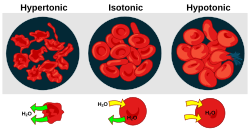Osmosis


Osmosis is the movement of water or other solvent through a plasma membrane from a region of low solute concentration to a region of high solute concentration.<ref>http://physioweb.med.uvm.edu/bodyfluids/osmosis.htm University of Vermont, Department of Physiology</ref> Osmosis is passive transport, meaning it does not require energy to be applied. What causes osmotic pressure is different concentrations of solutes on the two sides of the membrane.
When osmosis happens, water moves from the side of the membrane with a lower amount of osmotic pressure to the side of the membrane with the higher amount. An important example of osmosis is the movement of liquid (solvent) molecules across a cell membrane into a cell with a higher solute concentration. Osmosis is a fundamental part of cell biochemistry, but also has mechanical applications and usages.
Hypotonic, isotonic, and hypertonic[edit]


Solutions may have more or less solute per unit of solvent. The one with less is called Hypotonic. When the two solutions have equal concentration, they are isotonic. The one with more is Hypertonic. When the hypotonic solution is outside the cell,and hypertonic solution inside, the cell becomes swollen and distorted.
Cell membranes[edit]
The plasma membrane of a cell is semi-permeable, which means it allowed the entry of certain molecules in or out, it lets small molecules pass through, but blocks larger molecules,. The membrane also has ports or gateways which get certain macromolecules through. This is active transport, which uses energy and is selective. It is outermost covering of the animal cell. It is made up of proteins and lipids. Example:- Exchange of gases like oxygen and carbon dioxide.
Related pages[edit]
Ad. Transform your life with W8MD's Budget GLP-1 injections from $75


W8MD offers a medical weight loss program to lose weight in Philadelphia. Our physician-supervised medical weight loss provides:
- Weight loss injections in NYC (generic and brand names):
- Zepbound / Mounjaro, Wegovy / Ozempic, Saxenda
- Most insurances accepted or discounted self-pay rates. We will obtain insurance prior authorizations if needed.
- Generic GLP1 weight loss injections from $75 for the starting dose.
- Also offer prescription weight loss medications including Phentermine, Qsymia, Diethylpropion, Contrave etc.
NYC weight loss doctor appointmentsNYC weight loss doctor appointments
Start your NYC weight loss journey today at our NYC medical weight loss and Philadelphia medical weight loss clinics.
- Call 718-946-5500 to lose weight in NYC or for medical weight loss in Philadelphia 215-676-2334.
- Tags:NYC medical weight loss, Philadelphia lose weight Zepbound NYC, Budget GLP1 weight loss injections, Wegovy Philadelphia, Wegovy NYC, Philadelphia medical weight loss, Brookly weight loss and Wegovy NYC
|
WikiMD's Wellness Encyclopedia |
| Let Food Be Thy Medicine Medicine Thy Food - Hippocrates |
Medical Disclaimer: WikiMD is not a substitute for professional medical advice. The information on WikiMD is provided as an information resource only, may be incorrect, outdated or misleading, and is not to be used or relied on for any diagnostic or treatment purposes. Please consult your health care provider before making any healthcare decisions or for guidance about a specific medical condition. WikiMD expressly disclaims responsibility, and shall have no liability, for any damages, loss, injury, or liability whatsoever suffered as a result of your reliance on the information contained in this site. By visiting this site you agree to the foregoing terms and conditions, which may from time to time be changed or supplemented by WikiMD. If you do not agree to the foregoing terms and conditions, you should not enter or use this site. See full disclaimer.
Credits:Most images are courtesy of Wikimedia commons, and templates, categories Wikipedia, licensed under CC BY SA or similar.
Translate this page: - East Asian
中文,
日本,
한국어,
South Asian
हिन्दी,
தமிழ்,
తెలుగు,
Urdu,
ಕನ್ನಡ,
Southeast Asian
Indonesian,
Vietnamese,
Thai,
မြန်မာဘာသာ,
বাংলা
European
español,
Deutsch,
français,
Greek,
português do Brasil,
polski,
română,
русский,
Nederlands,
norsk,
svenska,
suomi,
Italian
Middle Eastern & African
عربى,
Turkish,
Persian,
Hebrew,
Afrikaans,
isiZulu,
Kiswahili,
Other
Bulgarian,
Hungarian,
Czech,
Swedish,
മലയാളം,
मराठी,
ਪੰਜਾਬੀ,
ગુજરાતી,
Portuguese,
Ukrainian